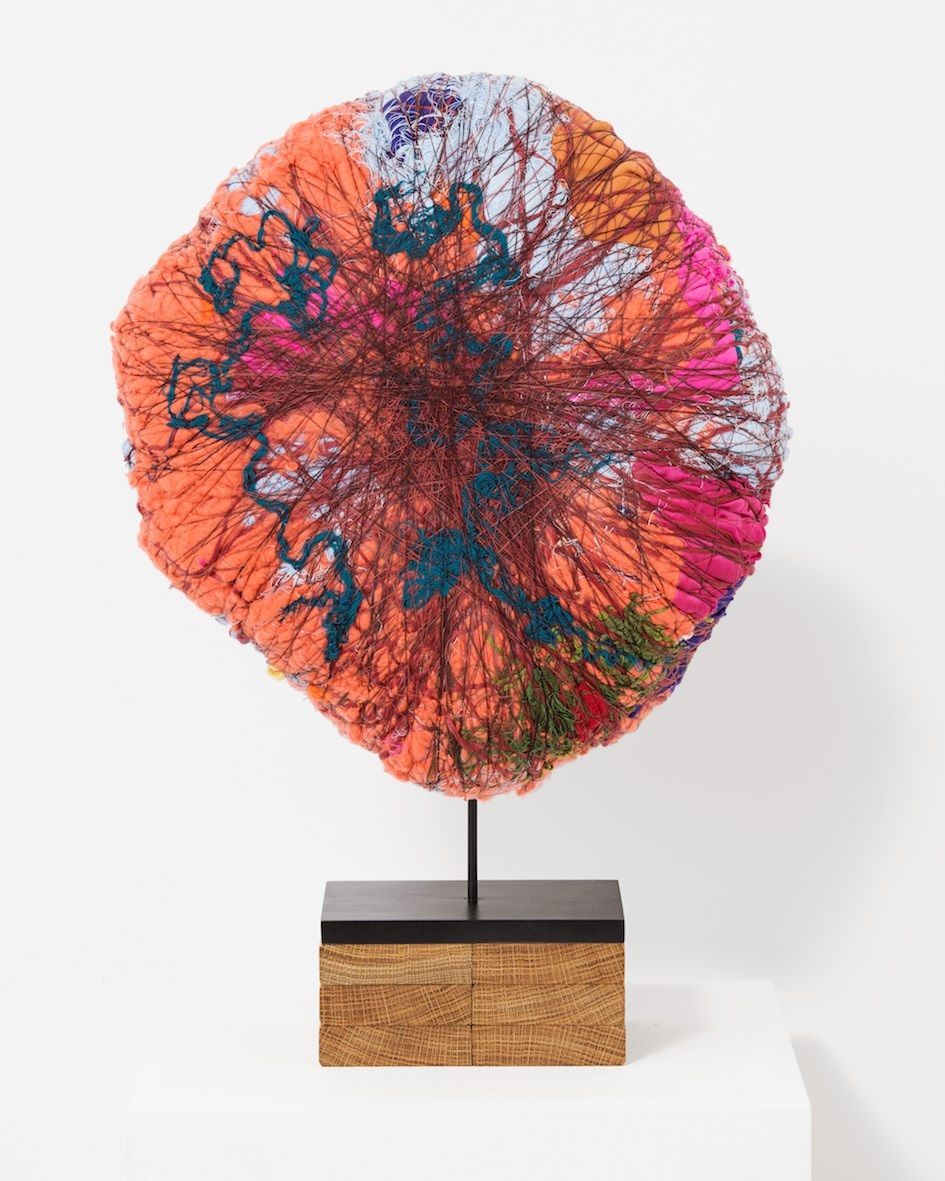Sheila Hicks
Chilpancingo
, 2019Chilpancingo is named after Chilpancingo de los Bravo (commonly shortened to Chilpancingo), the capital and second-largest city of the Mexican state of Guerrero, where Sheila Hicks lived and worked from circa 1959 to 1964, after which she relocated to Paris.
It was here, learning from traditional textile craftspeople, that Hicks developed the skills as a fibre artist that would bring her international acclaim in the years to come. Andrew Gardner (Curatorial Assistant, Department of Architecture and Design, MoMA, Museum of Modern Art, New York, NY, U.S.A.) writes (in ‘Sheila Hicks American, born 1934’):
Her diverse approach to textiles put her at the center of the burgeoning Fiber Art movement of the 1960s and ’70s, in which artists, including Lenore Tawney and Magdalena Abakanowicz were inventing new possibilities for pliable mediums. They created sculptural and three-dimensional fiber works that upended conventions, establishing a new order in the largely male-dominated arena of two-dimensional tapestry-making. Hicks continues employing intensely saturated color and the raw materials of textiles—wool, synthetic thread, linen flax—in works that are rigorously constructed by wrapping, piling, and weaving her materials.
Hicks has explored dyeing and textile traditions through extensive travels across several continents (honing her craft in a variety of countries like Chile, Mexico, Morocco, India and France), where she immersed herself in local communities and studied vernacular textile traditions by observing and collaborating with local artists and artisans, creating a body of work that has, gradually, moved off the grid of the loom into sculptures using skeins of thread, bundles of fluffy fibre and found materials ranging from porcupine quills to corn husks.
Since the 1970s, Hicks has established herself as one of the most distinctive artists of her generation. Working to manoeuvre colour, texture and form, the Paris-based artist has produced a rich and complex body of large-scale bas-reliefs, sculptures and installations that indulge in material tactility and the collective experience of space.
Hicks, enormously sensitive to space and light, has collaborated with architects throughout her career, stitching and weaving huge wall panels for the Ford Foundation headquarters and Eero Saarinen’s (1910–1961, American architect and industrial designer) building at JFK Airport, both in New York, NY, U.S.A. These and other prestigious collaborations and commissions (including, amongst others, the King Saud University in Riyadh, Saudi Arabia; the Cultural Centre of Fuji City in Japan as well as projects with IBM, CBS, Air France, Rothschild Bank, Bridgestone, Artek and Georg Jensen) have enabled Hicks to collapse the boundaries between art, architecture and design.
Hicks is also at her most recognisable when producing monumental hangings, tapestries, bas-reliefs and sculptures. The Questioning Column (2016), for instance, first installed at the entrance of the 2016 Sydney Biennale, rose to over 7 metres, while Escalade Beyond Chromatic Lands, presented at the 2017 Venice Biennale, saw an avalanche of synthetic, brilliantly coloured bales piled up to the ceiling of the Arsenale. For the 2020 iteration of the Nuit Blanche festival in Paris, Hicks suspended a luminous constellation of comets from the colonnades connecting the Musée d’Art Moderne de Paris and the Palais de Tokyo, an architectural reminder of the fleeting nature of lived experience.
Chilpancingo, however,belongs to a group of smaller free-standing three-dimensional works by the artist, executed in linen and synthetic fibres. It was while writing a paper on ancient Andean textiles for George Kubler’s (1912–1996, American art historian, among the foremost scholars on the art of pre-Columbian America and Ibero-American Art, and Sterling Professor of the History of Art at Yale University, 1975-1983) class at Yale that Hicks taught herself to weave on a backstrap loom of tree branches and assemble threads on a small frame made of painting stretchers. To this day, Hicks still uses painting stretchers to create intimate works, which she refers to as ‘mimimies’. Hicks’ smaller works allow a valuable glimpse into the artist’s process, as well as her enduring interest in construction and material relationships. Regardless of scale, hers is a project of tactility and sensuality; of felt connection and the communication thereof. ‘Hands, eyes, brain’, noted Hicks at one point, ‘it’s the magic triangulation. It comes from passion, heart and intellect inseparably cemented to your times and to your emotional experiences’.
Chilpancingo is a very good example of Hicks’ groundbreaking and deeply personal way of bringing out the artistic qualities in textile matters. Having moved on from painting to textile, distinctly painterly qualities remain in her use of colour and in its expressive and saturated qualities in the yarns that have become her trademark. This practice has been a constant in all her abstract works, which have varied in size over the years, from a few centimetres to filling an entire room from floor to ceiling. These remarkable qualities were touched also upon in the exhibition catalogue when Firestorm Foundation acquired Chilpancingo at the 2019 CFHILL exhibition, All Movements Have Memories, in Stockholm:
The works in this exhibition are taken from the series Delicate Secrets. They are round, soft objects mounted on stands, with thin strands of yarn wrapped around bright orange and pink fulled wool parts. They resemble biological samples or exhibits in ethnographic museums, or perhaps models of heavenly bodies in a planetarium. Hicks’s textile objects have a particular, secretive quality, an embracingness that seems to be protecting or preserving something within that requires sheltering. The quality of the wool itself adds a particular sense of warmth to the colours. In her art, more than any other artist, she has dissolved the boundaries between textile arts and crafts objects and abstract expressionist paintings. Her sensitive objects highlight the silenced, anonymous, and spectacular textile traditions that have existed all over the world, in every era of human history.
Provenance
CFHILL, Stockholm, All Movements Have Memories, 18 October-16 November 2019.
Firestorm Foundation (acquired at the above).
Copyright Firestorm Foundation
